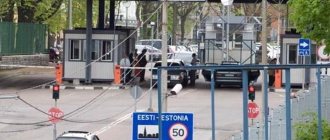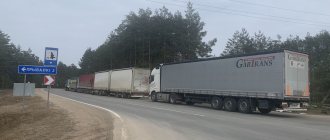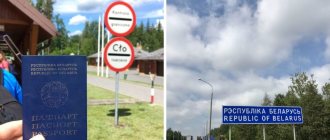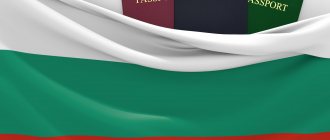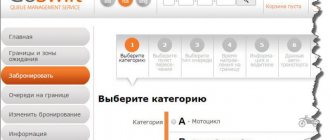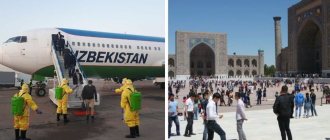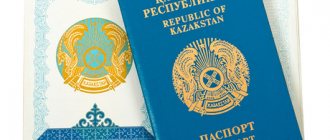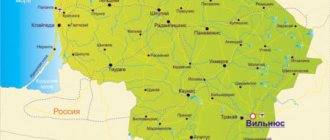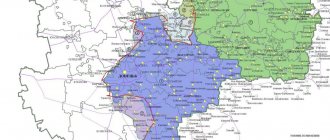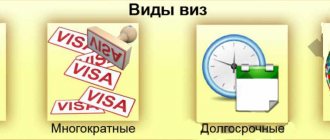The Estonian border is open from June 21 for vaccinated people
- From 21 June 2021, Estonia opened its borders to vaccinated tourists. The Russian vaccine Sputnik V is suitable for travel.
- Due to the spread of new strains of coronavirus in the Russian Federation, the Estonian authorities plan to require vaccinated people to have a negative PCR test, reports the website interfax.ru.
- Since September 2021, the Estonian border has reopened, but entry is not available to everyone.
- Only citizens of Australia, New Zealand, South Korea, Thailand, Singapore and Rwanda are allowed into the country as tourists without vaccinations.
The Estonian authorities announced the resumption of direct flights with Russia from April 25, 2021. Flights will be operated once a week on Sundays by Aeroflot.
You can get to Estonia through EU countries, as well as by car and ferry.
Russia-Estonia checkpoints: rules and features of border crossing
It is allowed to drive through the checkpoint by car, truck, bicycle, or on foot. Autotourists choose the checkpoint that is closest to them. Each point is open 24 hours a day, which is convenient for travelers. The busiest checkpoint is the Ivangorod – Narva checkpoint. In second place is “Kunichina Gora - Koidula”, and in third place is “Shumilkino - Luhamaa”. The waiting time at the checkpoint varies from 1-2 hours to 5 hours.
The procedure for crossing the Estonian border at the Ivangorod – Narva checkpoint
Passing customs and border control when crossing the border through the Ivangorod-Narva checkpoint from Russia occurs on a first-come, first-served basis. Before occupying it, it is strongly recommended to refuel the car, since this is the last opportunity to replenish its reserves at a reasonable price (there are gas stations, etc. in Ivangorod). To cross the border on the Russian side, you must present a passport with a valid visa and, upon request, allow the employees to inspect the vehicle.
On the Estonian side you will also have to present documents entitling you to enter the Schengen area. Checkpoint officers check for a valid visa, medical insurance, green card (international travel insurance), and also perform a visual inspection of the vehicle and luggage. If there are no complaints, travelers will have their documents returned and given the go-ahead to enter Estonia. The first point you will get to know will be the city of Narva - the third largest in the republic.
To cross the Estonian border with Russia through the Narva checkpoint in the opposite direction, you must pre-book a checkpoint time. This is very convenient, because in this case you will not have to stand in line, and crossing the border will pass quickly, without tiring waiting. When booking a time, you will need to provide passport details of all passengers in the vehicle, as well as pay a fee, the amount of which can be found on a special website (book your queue here). Residents of the Russian Federation can pay for the service with a credit card when making a reservation online, or with cash or a debit card in the waiting area.
However, you can cross the Estonian-Russian border on a first-come, first-served basis. However, only a small percentage of the checkpoint capacity is allocated for this type of crossing, so the wait can last for many hours. Currently, the cost of booking a queue at the Estonian border with Russia is 1 euro.
The procedure for crossing the border through the Kunichina Gora – Koidula checkpoint
The Russian-Estonian border crossing point Kunichina Gora is currently the only one for which you can pre-book a time to cross (you can do this here). Like the Ivangorod checkpoint, this one allows not only motor vehicles, but also pedestrians and cyclists. There is a toll road leading to the border checkpoint, for which you will have to pay a toll. The daily capacity of the point is 2000 people.
The border crossing procedure is standard. Here, documents are checked and baggage subject to this procedure is declared. There is a duty-free shop on the territory of the checkpoint.
To cross the Estonian-Russian border through the Koidula point, you must pre-book a time for passing control. Waiting for your turn takes place in a special area, which is a large open parking lot. There is also a large building in which there is a cafe, toilets and showers. The number of the person passing through customs control is displayed on a large screen, which is very convenient.
Shumilkino – Lahama
This checkpoint is the second busiest after Ivangorod-Narva. It has 4 border posts. And they move to the border point along the free Pskov-Riga road.
They travel to Shumilkino along a free route from Pskov. At the first checkpoint, the driver is given a ticket with the number of passengers. Only the driver can approach the border booth. Then they drive up to customs and passport control.
Follow the signs to select the required corridor. When the light is green, they drive up to customs and present their documents. After checking in front of the last barrier, they give back the ticket issued at the beginning and cross the Russian border, following to Lahama along the no-man's land.
At the Estonian checkpoint, everyone is checked only once. Therefore, the car owner will stop there only once. Border guards-police cars in Lahama are called for inspection with the right or left hand, depending on which row the vehicles are in. Therefore, it is necessary to constantly monitor their behavior so as not to miss their turn.
After being invited to the inspection, they drive up under the canopy where the white stop line is located, turn off the engine and hand over the previously prepared documents to the customs officer. Then the driver, together with the control officer, goes to the booth to mark the entry into the passports. Afterwards the documents are returned and the barrier is opened.
The procedure for passing the border between Russia and Estonia through the point “Shumilkino - Luhamaa”
The throughput capacity of the Shumilkino - Luhamaa point is 4,000 people per day. The closest large settlement to this checkpoint is Pskov, which is 60 kilometers from here. A two-lane asphalt road without a dividing line leads to the border checkpoint. The point in Shumilkino has four document control posts. There is also a duty free shop here.
To cross the border in the opposite direction, that is, returning from Estonia to Russia, you must book a checkpoint time in advance. Waiting for your turn takes place in a special area where there is a building with working cafes, toilets and showers. The point operates around the clock and serves both those traveling by car, pedestrians and cyclists.
Documents for crossing the border
- A foreign passport valid for at least 3 months from the date of departure from the country.
- Visa, residence permit or other document confirming the right to entry and stay.
- It is recommended to have medical insurance with you.
You can calculate the exact amount and apply for an insurance policy online here.
Electronic declaration
No earlier than 24 hours before crossing the border, but no later than boarding the plane to Estonia, you must fill out an electronic Health Declaration.
If the passenger has not previously filled out this document, he can do so directly at the border. The paper form is issued by the Border Guard Service.
Possibility of privileged crossing of the Russian-Estonian border
In general, crossing the border between Russia and Estonia at all three points occurs on a first-come, first-served basis or by appointment. However, in exceptional cases, you can cross the Russian-Estonian border in a privileged manner (and for this there is absolutely no need to brazenly jump in line, as was recently the custom among Caucasians when crossing the Russian-Georgian border at the Verkhniy Lars checkpoint). At the Russian-Estonian border, everything is reasonable and clearly regulated - the right to skip the border has the right to: - persons with serious health problems with a valid certificate - persons whose visa is expiring - persons who need to attend a funeral - persons who have the need catch a train or plane - persons who have a seriously ill relative - and all of the above must be confirmed by relevant official documents.
In addition, the following have the right to privileged crossing of the Russian-Estonian border: - employees of diplomatic missions and persons accompanying them - members of international delegations and representatives of consular services - vehicles transporting perishable goods - vehicles whose drivers have the right of privileged border crossing on the basis of international treaties and agreements - motorcycles of categories A and A1.
PCR test
- People coming from the UK, as well as from non-EU third countries, must present the results of a PCR test at the border.
- The test must be done no earlier than 72 hours before entering the country. The test can also be done upon arrival in Estonia at your own expense at the border.
- The certificate must be in English or Estonian.
Children under 12 years of age are exempt from taking the PCR test.
What documents can be presented instead of a PCR test?
In addition to a certificate of a negative PCR test, foreign citizens have the right to present one of the following documents when entering Estonia:
- A doctor’s certificate in Estonian, Russian or English confirming that you have had COVID-19 disease within the last 6 months. You can also present a printout from the medical institution’s database.
- An immunization passport or a notarized copy thereof or a vaccination certificate, which will reflect the personal data of the immunized person, for example, the disease against which the person was vaccinated, the date of immunization, the vaccine used, its lot number, the dose administered, the number of doses administered, name person who immunized the person and other data in Latin or Cyrillic, Estonian, Russian or English.
- The Estonian authorities plan to require a negative PCR test for all Russian citizens.
Requirements for a car when crossing the border between Russia and Estonia
First of all, the car must be technically sound and have readable license plates in accordance with legal requirements. Also, border guards often pay attention to the condition of the glass and headlights: the glass should not have cracks (at least the windshield in the driver’s line of sight) - Poles and, to a lesser extent, Finns are considered especially scrupulous in this matter. For the Balts, I didn’t notice any particular desire to find fault with the condition of the car, but it’s still better to put it in order before the trip. EU border officials have a very negative attitude towards any “radar detectors” and “video recorders” - so it is better to keep them away while crossing the border. As for the age of the car: there are no restrictions on age (unlike, for example, Azerbaijan) and environmental friendliness of the exhaust on the Russian-Estonian border, the main thing is that black smoke does not come out of the exhaust pipe. In exceptional cases, border crossing staff can check the CO content in the exhaust - but I have never encountered this. Regarding the additional equipment required to cross the border between Russia and Estonia: as far as I know, there is no clear list and the opinions of “experienced” people vary greatly, so I will give my version, formed after numerous trips by car to the countries of the European Union and Transcaucasia. Some of this list may seem superfluous to the reader, but there is always a possibility that some particularly zealous employee will decide to get to the bottom of something you are missing and thus ruin the start of your long-awaited vacation.
List of additional vehicle equipment for crossing the Russian-Estonian border:
Fire extinguisher RUS sticker on the trunk lid First aid kit according to TUV standards Warning triangle Tow rope Reflective vest Not necessary, but highly recommended on a long journey: A full set of tools for minor repairs Full-size spare tire Metal canister for fuel Pump Wheel wrench Jack Wire for “lighting” Wheel chocks shoes” – 2 pcs. (regarding the “shoes” - I came across information on the Internet that Estonian border guards check for them when crossing the border. I won’t lie, I’ve never been asked - but I take them with me just in case).
